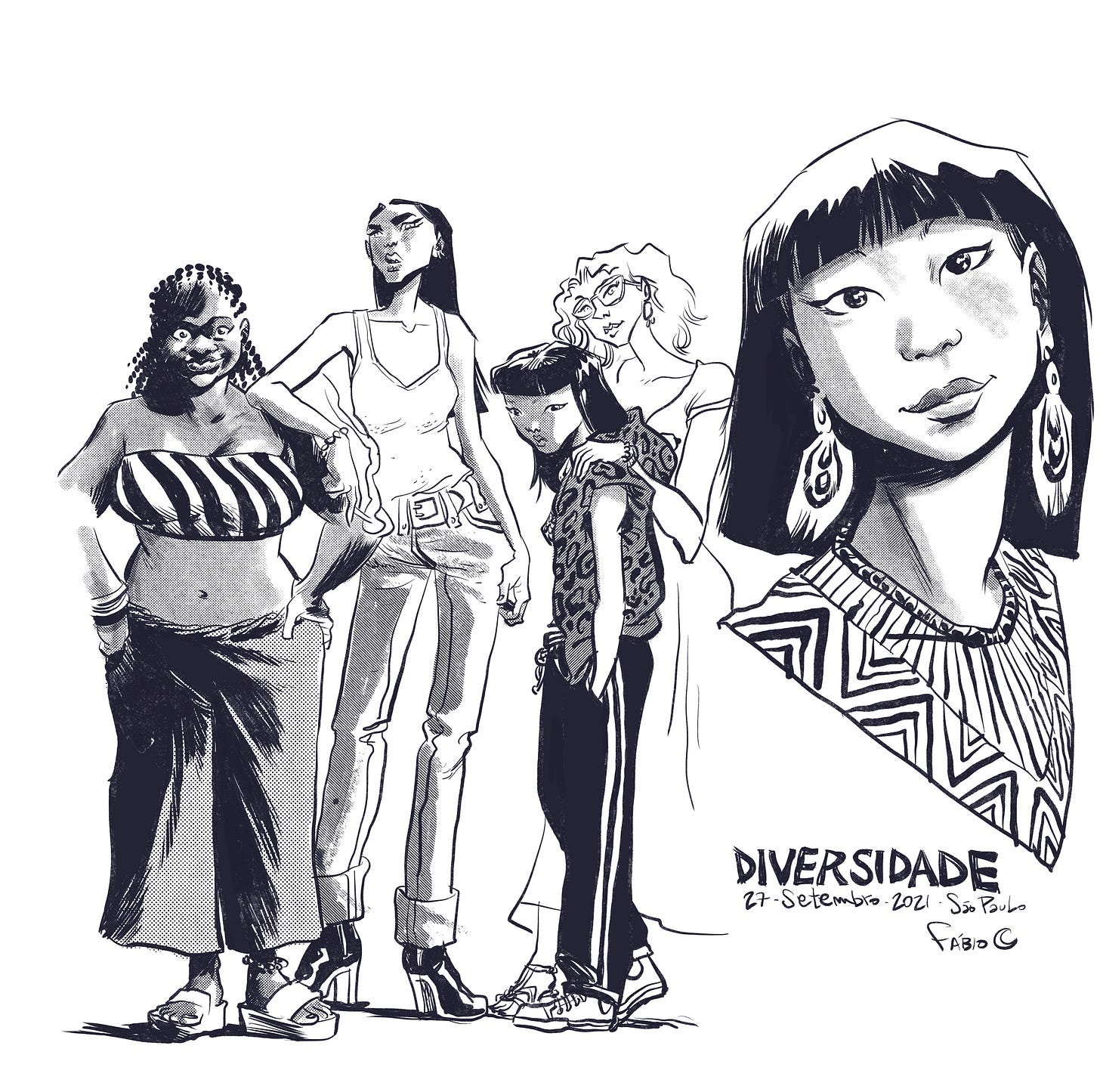Last week’s live drawings I did were about diversity. Prompted by something I read on twitter about illustrating diversity of races being more than just changing the color of the skin, I decided to focus on drawing people from asian or indigenous descent on my Monday morning live on Instagram.
On my afternoon live, I expanded from drawing only faces to draw body figures so I could go more diverse and try to show different body shapes. While on my morning drawings I used photographic references in order to really study the subtle differences in the features of the faces, like the shape of the eyes or the mouths or the jaw line, for my afternoon exercise I drew everything using the repertoire stored in my mind.
You need to practice how to look around you and what is there to see, what kind of details, what kind of stories. You need to practice your hand in order to learn how to translate that diversity in your drawings.
Maybe, if you don’t find diversity looking around, you need to get out more to discover the beauty of our more colourful World.
Learning about others and learning from others
I’m curious in nature. I’m always interested in learning more. I want to learn more about my work, about my craft, but also about my friends, or about places, cultures or cultural movements. During these pandemic times, the internet has been very helpful in providing new material to keep my hunger for knowledge fed.
I often link to the Cartoonist Kayfabe guys and their interviews with other artists. Besides the fact that Ed Piskor and Jim Rugg are about my age, so their pool of references is very similar to mine, they’re the kind of artists who are always trying to see what was going on on the World that influenced the choices the artists were making and how that shaped their stories, their styles and the reaction from the readers. Not only they’re interested in works that are still relevant today, but also in reflecting on the reasons these works were relevant or successful or controversial when they first came out. It’s no surprise that this weekend’s shoot interview with Klaus Janson was just my cup of tea.
Another channel of interviews and conversations I found online during the pandemic times is Comix Experience YouTube channel, where the owner Brian Hibbs talks to authors about comics, old and new. His recent talk with Dave McKean goes on about so much more than Dave’s latest book, Raptor, and it’s a great chat about how you can do your own thing in the comic’s market. Almost at the end, Dave says he believes we’re nowadays going through a golden age of comics, where the books published show the diversity of voices and origins of authors from all over the world. I think he’s right.
Podcasts have been another discovery of my pandemic life. Two I often listen to are Portrait of an Editor (specially the “cropped” episodes where the host talks to editor Will Dennis) and WTF with Marc Maron, this one is particular because I find the interviews rally engaging, and I’m fascinated by how well Marc researches the subject of his conversation, and how well he navigates the talk, making the guest comfortable and interested in talking about all sorts of interesting things.
The same story, but different
I have a t-shirt I bought in India when Bá and I went to a convention in New Delhi with a bunch of drawing of Indian faces, showing how diverse was the population and its culture. There was a phrase on top of the drawings saying “Same, same, but different”.
This past week, we were on a virtual panel as part of the celebration of 10 years since the first LIMA COMICS convention, and the topic of the conversation was comics that have been adapted into another media. We talked a little about our experience with the Umbrella Academy show on Netflix, and about working on the adaptation of Neil Gaiman’s How to Talk to Girls at Parties at the same time as a movie was being made from the same story (and we mentioned also the constant interest in adapting Daytripper and Casanova), and we listened to Leandro Fernandes talking about working on The Old Guard, and José Villarubia about his experience colouring Sweet Tooth.
That’s why I thought about my t-shirt.
Same, same, but different.
We had similar experiences.
The stories on the screen are similar to the ones on the page.
Still, in order to work on the screen, and to work in this different language, using different narrative tools, the stories must change, the characters sometimes must change, and it’s when they change that they remind us of the original characters of the story we wrote, drew and read. When the story is the same and at the same time different, the characters come alive and we recognise them.
You can see the video of the panel on this link. It’s spoken in Spanish.
Be safe. Be kind. Be curious
Pa-ZOW!
Fábio Moon
Moon Base, São Paulo
October 4th, 2021





